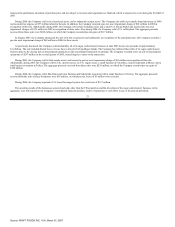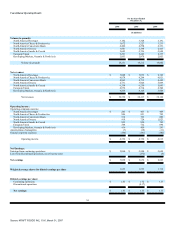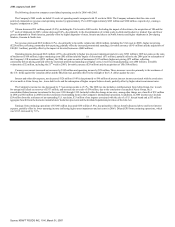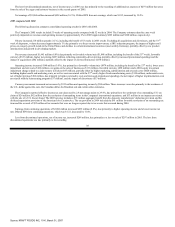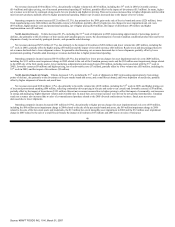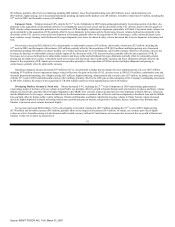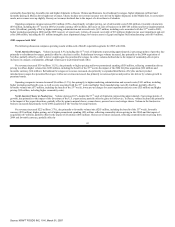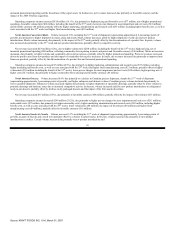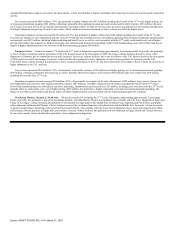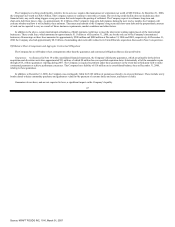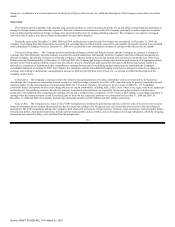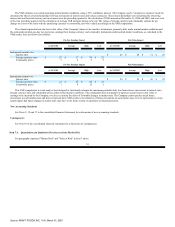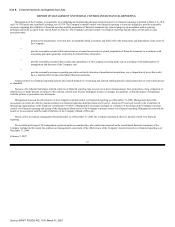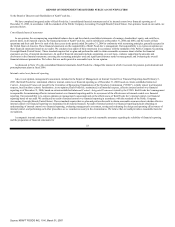Kraft 2006 Annual Report Download - page 47
Download and view the complete annual report
Please find page 47 of the 2006 Kraft annual report below. You can navigate through the pages in the report by either clicking on the pages listed below, or by using the keyword search tool below to find specific information within the annual report.
increased promotional spending and the divestiture of the yogurt assets. In foodservice, net revenues increased, due primarily to favorable currency and the
impact of the 2004 Veryfine acquisition.
Operating companies income increased $128 million (16.1%), due primarily to higher pricing and favorable costs ($77 million, net of higher promotional
spending), favorable volume/mix ($62 million, including the benefit of the 53rd week), lower pre-tax charges for asset impairment and exit costs ($61 million)
and favorable currency ($8 million), partially offset by higher marketing, administration and research costs ($57 million, including higher benefit costs, as well as
costs associated with the 53rd week) and higher fixed manufacturing costs ($22 million).
North America Convenient Meals. Volume increased 2.9% including the 53 rd week of shipments (representing approximately 2 percentage points of
growth), due primarily to higher shipments in meats, pizza and meals. Meats volume increased, aided by higher shipments of cold cuts and new product
introductions. Meals volume increased, due primarily to the impact of the 53rd week, partially offset by the discontinuation of a product line. In pizza, volume
also increased due primarily to the 53rd week and new product introductions, partially offset by competitive activity.
Net revenues increased $274 million (6.2%), due to higher volume/mix ($238 million, including the benefit of the 53rd week), higher pricing, net of
increased promotional spending ($20 million, reflecting commodity-driven pricing in meats and pizza) and favorable currency ($16 million). Meats net revenues
increased, due primarily to higher volume and commodity-driven price increases, partially offset by higher promotional spending. Pizza net revenues increased,
driven by positive mix from new products and the impact of commodity-driven price increases. In meals, net revenues increased due primarily to improved mix
from new products, partially offset by the discontinuation of a product line and increased promotional spending.
Operating companies income decreased $7 million (0.9%), due primarily to higher marketing, administration and research costs ($73 million, including
higher marketing and benefit costs, as well as costs associated with the 53rd week) and higher fixed manufacturing costs ($31 million), partially offset by higher
volume/mix ($51 million including the benefit of the 53rd week), lower pre-tax charges for asset impairment and exit costs ($28 million), higher pricing, net of
higher costs ($17 million, due primarily to higher commodity driven pricing) and favorable currency ($4 million).
North America Grocery. Volume decreased 0.6% due primarily to a decline in Canadian grocery shipments, despite the 53 rd week of shipments
(representing approximately 2 percentage points of growth), and higher enhancers and desserts volume. Canadian grocery volume declined due primarily to
lower vegetable shipments. Enhancers volume increased slightly due primarily to higher shipments of spoonable dressings, partially offset by lower volume in
pourable dressings and barbecue sauce due to increased competitive activity. In desserts, volume increased aided by new product introductions in refrigerated
ready-to-eat desserts, partially offset by declines in dry packaged desserts and the impact of the fruit snacks divestiture.
Net revenues increased $15 million (0.5%), due primarily to favorable currency ($48 million), partially offset by the impact of divestitures ($31 million).
Operating companies income decreased $299 million (29.2%), due primarily to higher pre-tax charges for asset impairment and exit costs ($211 million),
unfavorable costs ($37 million, due primarily to higher commodity costs), higher marketing, administration and research costs ($43 million, including higher
benefit costs, as well as costs associated with the 53rd week), lower volume/mix ($8 million), the impact of divestitures ($4 million) and higher fixed
manufacturing costs ($4 million), partially offset by favorable currency ($11 million).
North America Snacks & Cereals. Volume increased 3.3% including the 53 rd week of shipments (representing approximately 2 percentage points of
growth), as gains in biscuits and cereals were partially offset by a decline in salted snacks. In biscuits, volume increased due primarily to new product
introductions in cookies. Cereals volume increased due primarily to new product introductions and
43
Source: KRAFT FOODS INC, 10-K, March 01, 2007


